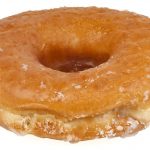 Although doughnuts no longer resemble nuts, they once did: the earliest references to doughnuts—in the early nineteenth century—reveal that the pastry was originally just a ball of sweetened dough fried in oil. Not until the mid nineteenth century did doughnuts acquire their hole, an innovation that solved a problem afflicting the original doughnuts: uncooked centres. Now a North American institution, the original doughnut was introduced by the Dutch settlers who founded New York City: they called their pastries oliekoek, meaning oil-cake, a word that became familiar to speakers of English in the nineteenth century, but never really challenged doughnut as the dominant name of the pastry.
Although doughnuts no longer resemble nuts, they once did: the earliest references to doughnuts—in the early nineteenth century—reveal that the pastry was originally just a ball of sweetened dough fried in oil. Not until the mid nineteenth century did doughnuts acquire their hole, an innovation that solved a problem afflicting the original doughnuts: uncooked centres. Now a North American institution, the original doughnut was introduced by the Dutch settlers who founded New York City: they called their pastries oliekoek, meaning oil-cake, a word that became familiar to speakers of English in the nineteenth century, but never really challenged doughnut as the dominant name of the pastry.
A circular-shaped, pastry-like concoction formed from dough that is deep-fried in oil until a delectable, golden hue is achieved. Although the circular form is its trademark, doughnuts may also be molded into rectangles, ovals, or a variety of other shapes. The dough used may be similar to that of cake or bread, and the doughnut may be unadorned, stuffed with fruit preserves or jelly, coated in a sugary glaze, or adorned with frosting. The term is also sometimes spelled “donut”.
Doughnuts are a type of cake that is made from slightly sweetened dough that is cooked in hot fat and then dredged with sugar. These confections can be made with either yeast or baking powder as a leavening agent. They are often filled with jam, jelly, or cream, or alternatively, dipped in sugar for added sweetness.
